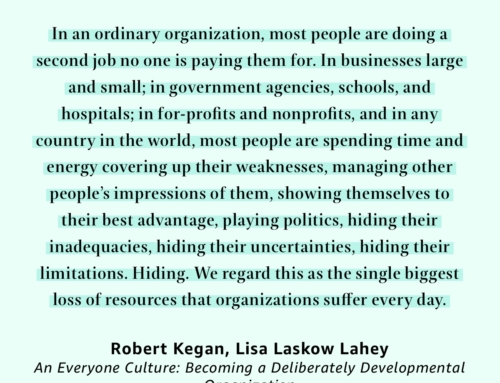LYSSA ADKINSFEBRUARY 23, 2012
I have a secret to tell you when it comes to facilitating agile teams. I’ll whisper it to you…
Most things work, until they don’t.
Yep, that’s it. That’s the secret. Whatever facilitation technique you use to help people communicate with one another, just know that any given technique will not work forever.
Think of it this way…Think back to when you chose the paint color for a room in your house. When you painted it on the walls, you noticed it. When you looked at it that first day, you really noticed it. You may have even smiled or felt happy about it. When you looked at it for the first few days or weeks, you still noticed it. And then, without warning and unknown to you, you just stopped noticing it. Well, it’s the same way with facilitation techniques.
Let’s say that you, like many ScrumMasters and agile coaches, are in the habit of asking, “Can we commit to this story?” each time the team takes a story into their sprint. Fine technique to help the team become conscious that they are making a commitment. Nothing wrong with it. Until the team stops noticing it. When they stop noticing it, they will go on auto-pilot and they will stop answering from their minds and hearts. Instead, they will answer from habit. And, they will stop making a *real* commitment.
Here’s another one. ScrumMasters and agile coaches I encounter say, “The team comes up with the same two things every retrospective or just says ‘We’re good.’ How can we have a better retrospective?” Nine times out of ten, when I ask them how they’re facilitating the retrospective, they say, “Oh, you know. I ask, ‘What went well, what could be improved.’ The basic retrospective questions.” I think this facilitation technique might only truly work once, yet I have encountered ScrumMasters and agile coaches who tell me they have been facilitating the retrospective this way for a year or more. The team probably went on auto-pilot after the first time!
So, what to do about this?
Notice the impact. For every single thing you do with a team, start paying attention to the team’s response. If they seem to be on auto-pilot, then use a different technique. Change it up. There is nothing in any of the agile frameworks that was meant to be an empty ritual that we just do again and again. Everything should be fresh and real every time. People should be interacting with one another, aided by your facilitation, from their minds and hearts. If you suspect something has turned into an empty ritual you can ask about it. “Hey, team, seems like we’re on auto-pilot here and not really engaged. Has this way of doing it become empty for you?”
Have a full toolkit. You need a lot of facilitation techniques at hand so that you can be ready to change it up when you need to. There is a whole facilitation chapter in the Coaching Agile Teams book, as well as activities that help the team interact throughout the book. Collaboration Explained and Agile Retrospectives are also full of useful activities and little (but powerful) facilitation techniques. My copies of these books are dogeared and coffee-stained. Having a full toolkit lets you pivot when you need to. Is the team bored with “Can we commit to this?” Well, then, change it up to consensus check (or something else – there are dozens of options).
Ask for openness. When I’m facilitating something that reveals what’s true to the group, like a constellation or like consensus check, or even planning poker, I find myself often saying stuff like this: “Stand where your heart tells you to stand.” “Vote your conscience.” “And now, with openness, vote.” And, in planning poker, “Is anyone compromising unwillingly?” I ask for the behavior we want – lightly, sometimes a little sillily. In doing so, I give them constant support to be honest with one another — because that can often be a hard thing to do.
Come back to the “why.” If the emptiness persists, even though you’ve changed how you’re facilitating things, then help the team reconnect to the “why” of each thing we do. In the facilitation chapter in the Coaching Agile Teams book, I offer the “why” of common recurring agile meetings. Just reveal the “why” to them and then ask,”Are we getting these benefits from this meeting? How would we rate ourselves? How would we get more of the benefits we’re supposed to be getting?” Remember, these are *their* meetings – not yours. You are simply (and powerfully) their facilitator. So, ask these questions and let them come up with ways to get more.
Get out of the middle. It’s about them interacting with them. Not them interacting with you. If all eyes are on you for most of the time then you’re in the middle. If they’re answering you, then you’re in the middle. Everything rides on the team members being able to make a commitment to one another — not to you. Use facilitation techniques that encourage them talking to them. Get yourself out of the middle. (another blog post about this)
Enjoy. Above all, enjoy this wonderful work you get to do as the ScrumMaster or agile coach. No one else is entrusted with helping the team become great. Only you. For those days when you can’t connect with the good reasons for doing agile well, check out this 3 minute video to get a fresh infusion of agile joy.





